[Click on BLUE links for sources and information]
I want to sleep in the country, by the river, to retrieve the dreams of my youth. Gerardo Navarro Gómez
The story of the life to date of the Zapotec, Oaxacan, Mexican artist Gerardo Navarro Gómez has been eloquently told by my friend, Alvin Starkman, in his illuminating post La Rubia Negra: The Erotic Art of Gerardo Navarro Gómez. The Dark Blond (La Rubia Negra) is the name of one of Gerardo’s erotic paintings. Without words the painting displays shame and deception and guilt and love and sex as only Gerardo could have done.
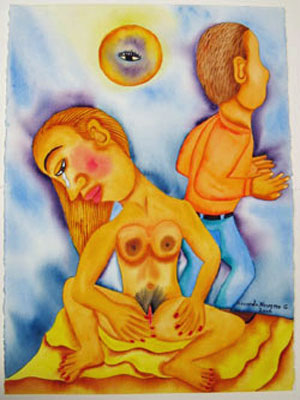
La Rubia Negra, Gerardo Navarro Gómez
Read Alan’s post and you will find how Gerardo was born in the small village of Santo Tomás Jalieza (Ocotlán de Morelos Oaxaca on October 3, 1958) where he still lives with his sisters and mother, how his sisters weave intricate designs on their backstrap looms using methods hundreds of years old, designs so compelling that four Mexican Presidents have purchased them, the last being President Vicente Fox who visited the Navarro Gómez sisters in their home. You will find how Gerardo was a misfit at school, how one perceptive teacher, Maestra Lupita, saw a spark in Gerardo that she kindled until it grew into the fire that is his art—an art of life, love, nature, women and eroticism. You will read how he left his village only to return a few months later realizing that everything he needed was there. You will see the equality of the sexes, the sharing of responsibilities, the simple day-to-day beauty of the communal lives of this immensely talented family. And you will see much more. So, click on the LINK and read it. Please.
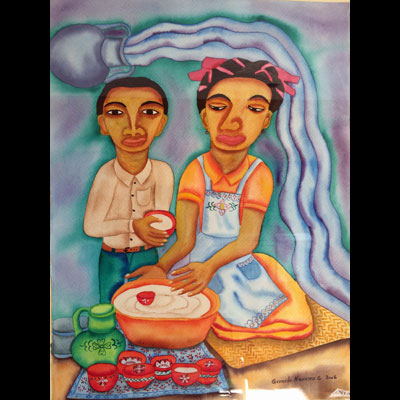
Water Color by Gerardo Navarro Gómez, Casa de las Bugambilias collection
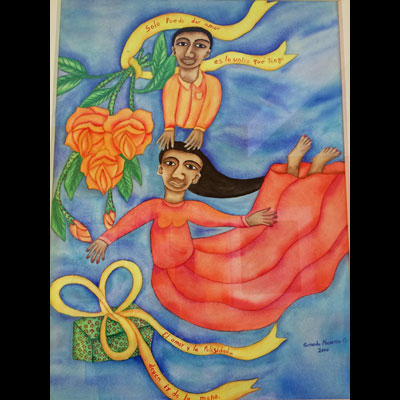
I can only give all the love I have; love and happiness go hand in hand. Water Color by Gerardo Navarro Gómez, Casa de las Bugambilias collection
Imagine a world where “everything that lives is holy,” a world where you see differently, where you are touched by a “stroke of incite” everywhere you look, a world like the one in your first fairytale where trees and plants, insects and animals and even rocks can speak and feel and see. Imagine a world of dreams, sex without shame, love without possession, a synesthetic world where color and shape are words, where words evoke shape and color. Imagine a world where love is cooked up in the kitchen, where parents plant the seeds of their children who grow like flowers, where greed can turn into an eagle that eats the greedy, where time shrinks and stretches, where people pour out their hearts from blackened ollas.
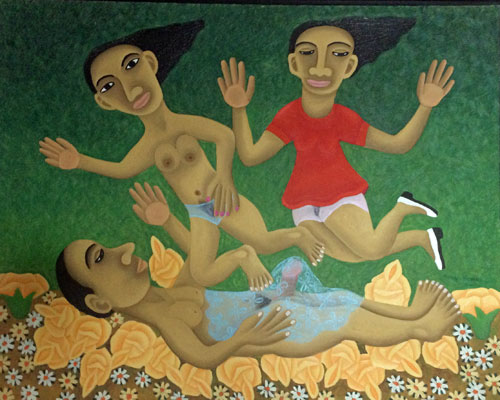
Oil on canvas by Gerardo Navarro Gómez
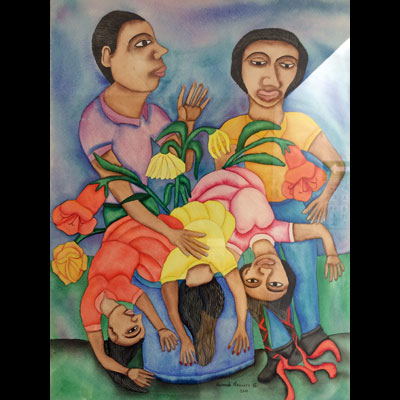
Water Color by Gerardo Navarro Gómez, Casa de las Bugambilias collection
… an outstanding reason for choosing some sort of god or spiritual-type thing to worship—be it J.C. or Allah, be it Yahweh or the Wiccan mother-goddess or the Four Noble Truths or some infrangible set of ethical principles—is that pretty much anything else you worship will eat you alive. David Foster Wallace, This is Water
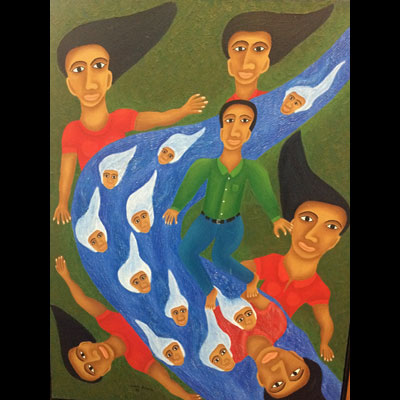
Rio de Juventud, (River of Youth) Gerardo Navarro Gómez, oil on canvas filmed in studio
This is the world as seen by Gerardo, a world Think in the Morning discovered when we visited.
Cooking is a common theme in Gerardo’s paintings. Perhaps this is why Casa de las Bugambilias and the restaurant La Olla next door have displayed so many of Gerardo’s paintings over the years.
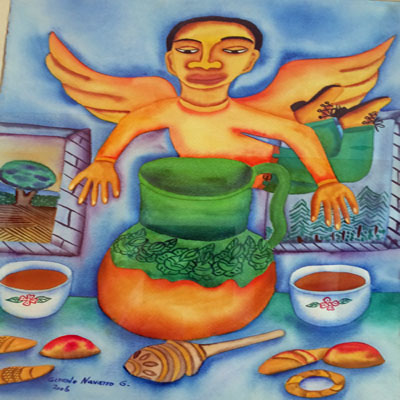
Water Color by Gerardo Navarro Gómez, Casa de las Bugambilias collection
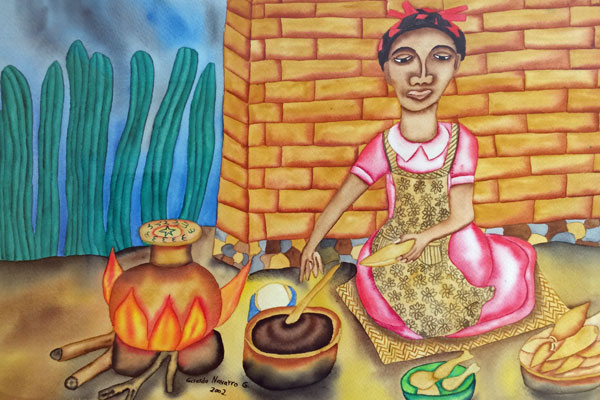
Water Color by Gerardo Navarro Gómez, Casa de las Bugambilias collection
Stealing us away from the women, Gerardo Gómez waves us into his painting studio. Fanciful dreamlike scenes decorate the walls and easels in the backrooms of the house. Gerardo’s colorful paintings all depict scenes from the short stories he writes. As he explains, sometimes he paints the picture first and sometimes he writes first and then paints the scene. Pulling an old notebook out of a pile of papers, Gerardo reads a story corresponding to one of his paintings in which a man’s ambition for wealth and power turns into an eagle which then devours him whole.
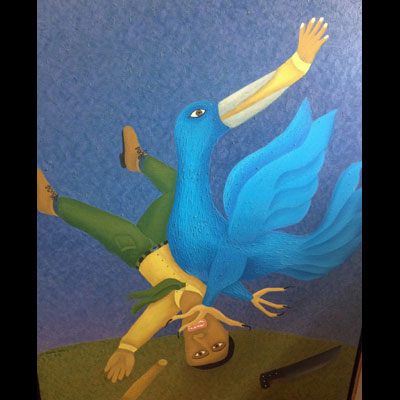
Gerardo Navarro Gómez, oil on canvas filmed in studio
Inspired by dreams and experience, Gerardo integrates painting and prose, using his art to illustrate the epic poems he writes about the Zapotec battling modernity. WHERE TO VISIT ALEBRIJE AND TEXTILE ARTISTS IN OAXACA
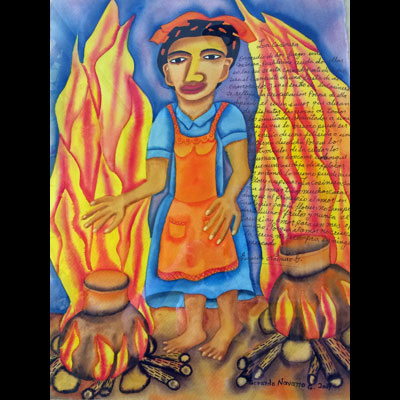
Water Color by Gerardo Navarro Gómez, Casa de las Bugambilias collection
La Cocinera (Gerardo Navarro Gómez)
Enmedio de dos fuegos una cocinera pueblerina cuida dos ollas en las que se esta cosiendo parte de lo que sera el una quete de una fiesta de dos enamorados y en el rostro de la cocinera se refleja la preocupacion porque de ella depende el buen savor que abran de disfrutar las voces de todos los invitados. Invitados a una fiesta que lo mismo puede ser el inisio de una felisidad o una eterna des dicha porque los sentimientos de la vida y los humanos son como un bosque que nunca se deja de explorar y en donde lo mismo puede ser sun flores o espinas. La cocinera sabe que el amor tiene muchas caras y aunque al prinsipio el amor en cualquier pareja florece, no siempre dara Buenos frutos y nunca se sabe si hay amor para un mes o para un ano. Porque el amor no crise como la ierva ni se compra en ningun mercado.
The Cook (Translated by TITM)
In the middle of two fires a small-town cook watches two pots where a party of two lovers is being sewn together. In the face of the cook concern is reflected because success depends on the good savor of the broth reflected in the voices of all the guests that enjoy it. All are invited to a party that will be the initiation of happiness, an eternal happiness because the feelings of life and humans are like a forest that never stops exploring and where flowers and thorns can be the same. The cook knows that love has many faces and although at the beginning the love in any couple flourishes, it will not always bear good fruits and you never know if there is love for a month or for a year. Because love does not create like the hand nor can it be bought in any market.
I am reminded of the beautiful story, Assembly Line, by B. Traven (author of The Treasure of the Sierra Madre). The story describes the meeting of an Indian campesino/artesano and a New York business man in a small village in Oaxaca, Mexico in the 1920’s. In a few thousand words, Assembly Line chronicles the life and struggles of an artist not so different from Gerardo and his sisters. Traven’s story contrasts the parallel worlds of a commodity economy, in which things are produced for their usefulness rather than their exchange value, and the mass production of a capital based economy.
Gerardo paints in vibrant watercolor. For his ink drawings he uses sepia tones. He has learned to match the brilliance of his watercolors with the oils he mostly paints with now. Think in the Morning purchased two watercolors. It was almost impossible to choose. However, given our collection of alebrijes we could not resist the painting of a woman who dreams the alebrijes into existence.
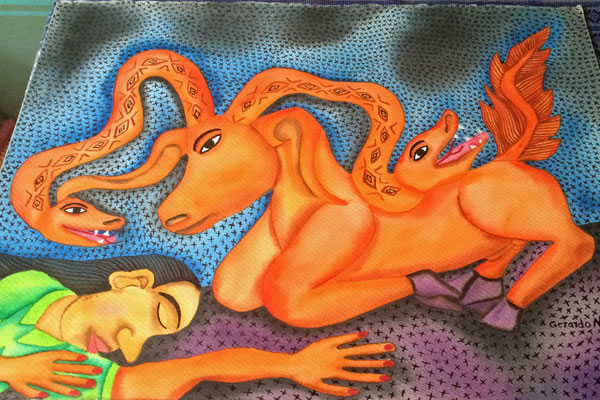
Magic Dream, Water Color by Gerardo Navarro Gómez
Our other choice was of the life-giving nature of trees, something we are well aware of living on the Mendocino coast.
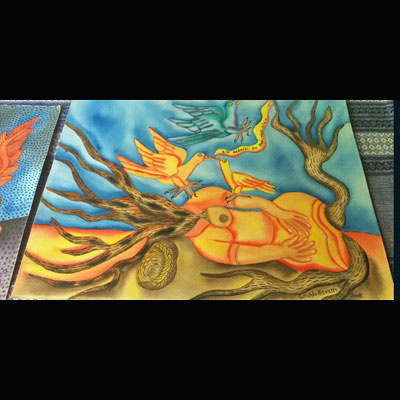
Sin Arboles No Podemos Vivir (Without Trees there can be no life), watercolor by Gerardo Navarro Gómez
A trip to a Central American jungle to watch how Indians behave near a bridge won’t make you see either the jungle or the bridge or the Indians if you believe that the civilization you were born into is the only one that counts. Go and look around with the idea that everything you learned in school and college is wrong. B. Traven: The Bridge in the Jungle
To further illuminate the differences between Gerardo’s world and ours, consider the Heinrich Böll Anecdote Concerning the Lowering of Productivity, something you may have heard reformulated as the story of a Mexican fisherman and the American businessman/tourist who tries to “improve” the fisherman’s life.
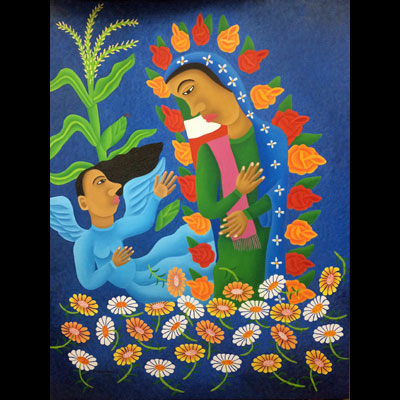
Mi Lupita (My Lupita), Gerardo Navarro Gómez, oil on canvas filmed in studio
Gerardo has created his own unique style. He’s self-taught. The oil above is a tribute to Maestra Lupita, the teacher who first recognized his talent. Some posters we saw in his studio indicate that he did study with a few masters along the way including Rudolfo Morales and Juan Alcázar and Justina Fuentes.
When I ask a friend of mine who comes from Mexico City what other Mexicans say about Oaxacans, she begins, of course, with the fact that they are widely considered to be incredibly hard workers.
Then she gives me an impish look and says, ”They like to have more than one woman in the house.” OAXACA by Jane Smiley
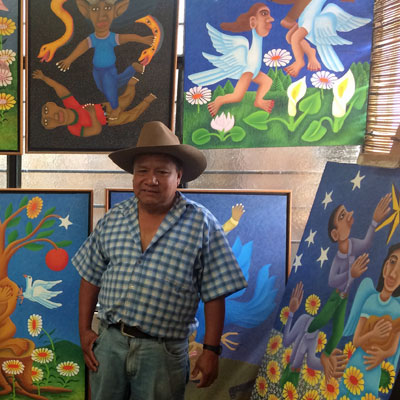
Gerardo surrounded by his oil paintings
A reluctant goodbye to Gerardo and his sisters, Think in the Morning motors off back to the beautiful city of Oaxaca. The streets of Santo Tomás Jalieza are immaculate. Some of the buildings are painted in the striking colors of Gerardo’s art. We pass a woman selling tejate, a popular drink of corn and cacao that has been consumed for centuries by the indigenous people of Oaxaca. Everything here has an ancient patina attached. Even the two Brahman bulls that greet us from a small pasture on the edge of town move at the same slow pace as their ancestors. Surely this was a day well spent.
Having visited Oaxaca every year for the past ten and often before that, TITM first experienced Gerardo’s art in what has become our home in Oaxaca, Casa de las Bugambilias. We have participated in our small way in the Cabrera family that owns and operates the B&B and in the lives and families of the staff all of whom we cherish as our own extended family. TITM thanks everyone at Bugambilias for their assistance with this article.

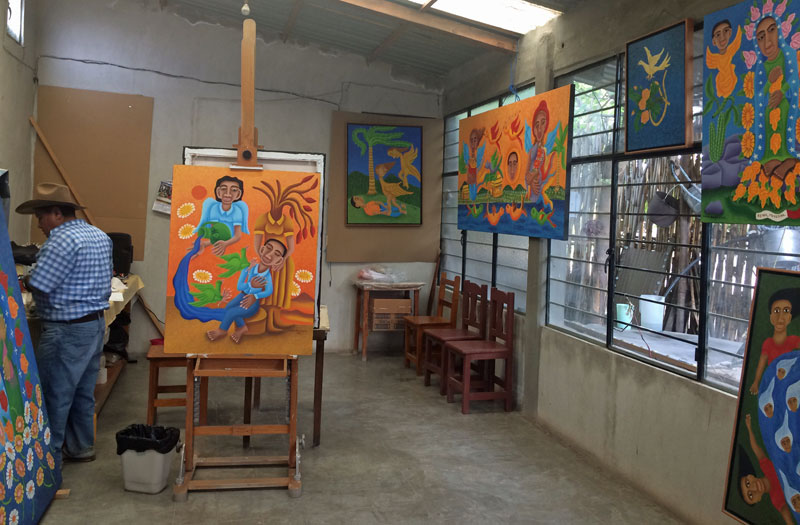
Scandalous, delectable, edible, juicy, serene, psychedelic, salacious, innocent, diabolical, holy, profane, naive, delirious, sophisticated, primitive, seething, soothing.
As always, you send me to my dictionary. Thanks. So much.
As long as I didn’t send you to the phone book.
David! ~
WoW! Thank You for this post!
Gracias!
I’m so happy you like it. Thanks !
I took a cooking class by Susanna Trilling many years ago in Oaxaca. She took us to the pueblo where Gerardo lived with his sisters. To this day, one of his paintings hangs on my living room wall.
Susanna was a lovely talented woman that I was privileged to know, just a little. I have her cookbook on the seven moles. I miss her and I miss Oaxaca. Thanks for your comment. I have took of Gerardo’s paintings as well.